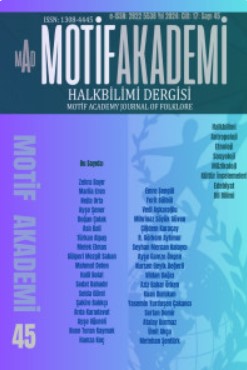KÜLTÜREL KİMLİĞİN OLUŞTURULMASI BAĞLAMINDA 23 NİSAN ULUSAL EGEMENLİK VE ÇOCUK BAYRAMI
23 APRIL NATIONAL SOVEREIGNTY AND CHILDREN'S DAY IN THE CONTEXT OF BUILDING CULTURAL IDENTITY
Author(s): Gülperi MEZKİT SABANSubject(s): Cultural history, Customs / Folklore, Interwar Period (1920 - 1939), Politics and Identity
Published by: Motif Halk Oyunları Eğitim ve Öğretim Vakfı
Keywords: Atatürk; Children's Day; April 23; ceremony; identity;
Summary/Abstract: Research on child and child folklore began in the eighteenth century in the west; It could also be handled in the nineteenth century in the Ottoman society. Before this period, since the child was not considered as a “separate individual”, there are no comprehensive studies on it. For this reason, the concept of child has been named as “the invention of the modern era”. Socio-political changes that developed with modernization in the last century of the Ottoman Empire, II. With the Constitutional Monarchy, it was aimed to raise children, who are the “rulers of the future”, with “nationalist” values, which were the dominant motto of the period, based on the “realization” of the child and understanding that it would be massacred through education. In this context, the opening day of the parliament, 23 April 1920, as well as the anniversary of the National Sovereignty Day, were first announced by the Himaye-i Etfâl Society in 1925 under the name of “children’s week”. As a result of the World War I and the War of Independence that followed one after another, a large part of the male population of the country was destroyed; For this reason, April 23, 1926, which was the day on which “badges and stamps” were sold, was declared as “Children’s Day”, which was created by the Himaye- i Etfâl Society on a “benefit basis”, during the disintegration of many families and the children faced with hunger and misery. The administrators of the republic also benefited from the transformative power of the ceremonies to bring the people together, to convince them of the ideas systematized by the newly established state, to adopt these thoughts and to continue them in ritual. In this context, national holidays, which are also known as the areas where nationalist ideas are experienced “the most intense”, and thus ceremonies have been evaluated as a parameter that creates and transforms the “national” identity of children. New icons and symbols of the Republic of Turkey was founded, thoughts and values of transmission space as seen April 23 Children's Day, “the arrival of a new baby into the world” was seen as synonymous with the birth. This metaphor, newborn babies, April 23 Children’s Day as the date they are announced yet they are seen as peers with the state and they are newly established six-in-seven years old and children as well as the Republic of Turkey 'life nativity feast' as named. A series of teachings which became the modern ritual of the scope of children’s holiday, and create a modern children’s future “of modern Turkey, it was seen as” the main objective to create. In the Early Republican Period, raising “nationalist children” within the scope of the nation-state project was presented as a “national / national duty” by the Republic administrators; All segments of society, from public institutions to non-governmental organizations and the smallest unit of society, the family, were expected to participate in this task; children are also expected to acquire “superior qualities that suit a Turk”, presented to them as “ideal”.
Journal: Motif Akademi Halkbilimi Dergisi
- Issue Year: 17/2024
- Issue No: 45
- Page Range: 113-129
- Page Count: 17
- Language: Turkish

